
When shopping for a monitor, enthusiasts have a dizzying array of choices. Once you’ve settled on a size and resolution, there are still the matters of refresh rate, ergonomics, color accuracy, brightness and connectivity. We test all of these variables in our display reviews so that you can determine the right screen for your unique needs.
Price versus performance is certainly key in any display purchase decision. But it’s also important to pick the right tool for the task. To that end, we’ve broken up our monthly round-up into display categories rather than price range. Our editors don't believe it makes sense to base buying decisions solely on cost. You may find you need a factory calibration or extra-fast refresh rate. To get those features, you’ll have to spend some extra coin. You may decide you don’t need a wide gamut or 32-inch panel. Then you can look to the cheaper categories.
How We Test Monitors
To better understand our testing methods and parameters, please read Display Testing Explained: How We Test Monitors And TVs. We've also published several articles on display calibration procedures and imaging science:
MORE: How To Calibrate Your HDTV
MORE: Display Calibration 101: Step-By-Step With Datacolor's Sypder4Elite
MORE: Do It Like Tom's: Calibrating Your Monitor With Calman RGB
MORE: Display Calibration 201: The Science Behind Tuning Your Monitor
If you're new to our display coverage, these articles will tell you how we test and how the results impact image quality.
June 2015 Updates
To keep our monitor coverage as relevant as possible, we’re currently concentrating on three major areas – gaming, Ultra HD and curved screens. The gaming category is now a hot topic of discussion thanks to the introduction of AMD’s FreeSync technology. We’ve published our review of the BenQ XL2730Z and you will soon see the Acer XG270HU tested here. Despite much debate about the merits of G-Sync versus FreeSync and some perceived flaws in both technologies, our experience so far has been positive.
Our only complaint is the fact that fast gaming displays still rely on TN panels to achieve their 144Hz refresh rates. Acer and LG however are trying to bring IPS to the mix with the XB270HU and 34UM67 respectively.
Acer’s XB270HU holds tremendous promise with not only an IPS panel but a 144Hz refresh rate which is a first. It uses G-Sync to match frame rates and also incorporates blur-reduction, another first in the IPS world. Our sample should be arriving in the lab soon and we’ll have a full report when it does.
LG has chosen to go with FreeSync for its first frame rate matching offering with the 21:9-aspect 34UM67. It’s also an IPS panel but with a maximum refresh rate of 75Hz. That’s another sample that is currently on its way to us and we’ll have that review finished shortly as well.
We’re exploring a new category in Ultra HD monitors this month starting with our upcoming review of ViewSonic’s VP2780-4K. This display brings 3840x2160 resolution to the 27-inch size which results in a pixel density of 163ppi. This particular screen also sports a factory calibration that has proved to be very accurate making it an excellent value for graphics professionals at just over $800.
Speaking of pro screens, we’ve added NEC’s Ultra HD flagship PA322UHD to our recommended list. This 32-inch display is only the second of its category to offer a wide gamut option. Previously your choices were to go with the Dell UP3214Q or a 24-inch UHD monitor. The new NEC is expensive at around $3000 but it provides near-perfect color accuracy and excellent contrast.
We’re still getting a trickle of new curved screens in for testing as well. Sitting on our test bench now is Dell’s U3415W. With 3440x1440 resolution, it offers the same 109ppi pixel density as a 27-inch QHD display with bonus width. And the curve does offer a slightly more immersive quality just like we saw in our review of LG’s 34UC97. The curve and the extra pixels will still cost you around $1000. Hopefully it will catch on and bring prices down.
It seems there is a lot to watch for in the coming months. We’ll continue to explore the G-Sync versus FreeSync debate as we get more monitors to test. And inevitably there will be driver updates to add improvements to the user experience. For now FreeSync is first-generation tech and while it’s perfectly usable in our opinion, it’s logical to assume it will be better down the road.
As always, thanks for reading and stay tuned for the latest here in these pages!
Gaming
| 2015 Editor Recommended | 2015 Editor Recommended | 2015 Editor Recommended | 2015 Editor Recommended | 2015 Editor Recommended | 2014 Smart Buy | 2014 Smart Buy | 2014 Smart Buy | 2013 Smart Buy | |
| Products |
 |
 |
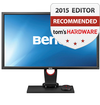 |
 |
 |
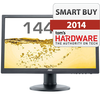 |
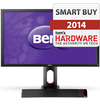 |
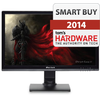 |
 |
| Pricing | |||||||||
| Screen Size | 24-inch | 24-inch | 27-inch | 24-inch | 24-inch | 24-inch | 27-inch | 27-inch | 24-inch |
| Aspect Ratio | 16:9 | 16:9 | 16:9 | 16:9 | 16:9 | 16:9 | 16:9 | 16:9 | 16:9 |
| Panel Type | TN | TN | TN | TN | TN | TN | TN | IPS | TN |
| Backlight Type | W-LED | W-LED | W-LED | W-LED | W-LED | W-LED | W-LED | W-LED | W-LED |
| Max Resolution | 1920x1080 | 1920x1080 | 2560x1440 | 1920x1080 | 1920x1080 | 1920x1080 | 1920x1080 | 2560x1440 | 1920x1080 |
| Max Refresh Rate | 144Hz | 144Hz | 144Hz | 144Hz | 144Hz | 144Hz | 144Hz | 120Hz | 144Hz |
| Color Depth | 8-bit (6-bit w/FRC) | 8-bit (6-bit w/FRC) | 8-bit | 8-bit | 8-bit (6-bit+FRC) | 8-bit (6-bit w/FRC) | 8-bit (6-bit w/FRC) | 8-bit | 8-bit (6-bit w/FRC) |
| Color Gamut | sRGB | sRGB | sRGB | sRGB | sRGB | sRGB | sRGB | sRGB | sRGB |
| Response Time (GTG) | 1ms | 1ms | 1ms | 1ms | 1ms | 1ms | 1ms | 6ms | 1ms |
| Brightness | 350cd/m² | 350cd/m² | 350cd/m² | 350cd/m² | 350cd/m² | 350cd/m² | 300cd/m² | 380cd/m² | 350cd/m² |
| Video Inputs | 1 DisplayPort | 1 DisplayPort, 1 DVI, 2 HDMI, 1 VGA | 1 DisplayPort, 1 DVI, 2 HDMI, 1 VGA | 1 DisplayPort, 1 DVI, 2 HDMI, 1 VGA | 1x DisplayPort, 1x DVI, 2x HDMI | 1 DisplayPort, 1 DVI, 1 HDMI, 1 VGA | 1 DisplayPort, 1 DVI, 2 HDMI, 1 VGA | 1 DVI | 1 DisplayPort, 1 DVI, 1 HDMI |
Now that we’ve seen monitors hit 120 and 144Hz, it seems like a run-of-the-mill 60Hz screen just won’t cut it attached to a high-end graphics card. With the advent of G-Sync and the imminent appearance of Adaptive-Sync, we think gamers will flock to these new technologies. We're also seeing the addition of backlight strobes to some models in order to reduce motion blur.
- Out-of-box color and grayscale errors of less than four Delta E
- Color and grayscale can be calibrated to errors of less than three Delta E
- Gamma tracking should be close to 2.2
- Maximum refresh should be at least 96Hz
- Screen draw time of under 10 milliseconds
- Total input lag of less than 40 milliseconds
- Motion blur reduction
AOC G2460PG
2015 Editor Recommended
Obviously we’re fans of G-Sync and were glad when Asus finally delivered the ROG Swift PG278Q to our labs back in August. Since then we’ve seen many more announcements but no more actual shipping product until AOC sent us its new G2460PG.
It’s a little smaller at 24 inches and gives up some pixel density with 1920x1080 resolution but it still packs all the speed and features of the Swift for about half the money. It has a great motion-blur-reduction feature (ULMB) that only costs you about half your light output. It also has separate brightness and contrast settings so you can optimize brightness whether ULMB is on or off. Of course G-Sync works just fine as long as you’re running a GeForce 650Ti or better.
We got a nice surprise when we calibrated the G2460PG. Most gaming monitors deliver fair accuracy but this AOC can run with a professional screen in grayscale accuracy and nearly so when the color gamut results come in. We know gamers aren’t looking for perfect color but it’s sure nice to have anyway.
The best part about this gaming display is it sells for about half the price of a ROG Swift. Granted it’s smaller and has lower pixel density but if you can afford the ROG, you can afford two G2460PGs. We hope it’s the start of a trend in value-priced gaming monitors. When more full-featured products like this become available, prices invariably drop. If you looking to add G-Sync to your rig, definitely check this new AOC out. Read the Full Review
BenQ XL2430T
2015 Editor Recommended
If you aren’t looking for G-Sync but still want the benefits of a 144Hz refresh rate and motion-blur reduction, BenQ has several products that might be of interest. The newest one is the 24-inch XL2430T. It’s a TN monitor like all the other gaming screens we’ve tested and acquits itself well in pretty much all areas of build quality and performance.
To make the best use of blur-reduction, a monitor must have strong light output to overcome the dimming that occurs with backlight strobing. The XL2430T delivers in spades with almost 370cd/m2 of brightness. But here’s the best part – blur-reduction will only cost you 51 percent of that. That’s one of the smallest reductions we’ve measured so far. Where other displays force you to compromise, BenQ’s new screen gives you the best of both worlds. And you get nearly 1000:1 measured contrast to boot.
Other points in favor of the XL2430T are its excellent out-of-box color and grayscale accuracy. We understand that few gamers will calibrate their monitors. BenQ understands that too and endows its new display with a stock grayscale tracking error of only 1.44 DeltaE and a color gamut result of 2.4dE as measured in our tests. With those numbers, you can just plug and play without worrying about color quality.
Another cool feature we like is the S Switch. It controls the OSD with a wheel- and button-encrusted puck and can sit on the base or be moved around the desktop. It’s one of those features we wish came on every monitor because it makes using the menus super-easy. That coupled with superb build quality makes the BenQ XL2430T a winner in our book.
Asus also includes built-in blur reduction with its ULMB feature. Experienced users know that backlight strobing can reduce brightness, so the ROG Swift exposes multiple settings, allowing you to strike just the right balance between blur reduction and light output.
On top of that, you get a QHD (2560x1440) panel. High resolution and unparalleled speed (plus G-Sync) make this our favorite gaming monitor right now. Read the Full Review
BenQ XL2730Z
2015 Editor Recommended
After months of announcements and speculation we finally got our hands on our first FreeSync product, BenQ’s XL2730Z. This is a premium product with BenQ’s famous build quality and gaming features galore like programmable settings modes, an S-Switch OSD controller and an excellent blur-reduction feature.
In our tests it proves to be a solid performer with contrast ratios just below 1000:1, good out-of-box grayscale accuracy and top-notch color quality. After calibration, we achieved nearly pro-level numbers with grayscale errors averaging just .72dE and a color gamut result of 1.44dE.
In the off-angle viewing test, we lamented BenQ’s use of a TN panel but noted that it was one of the best of its type we’d seen. Those observations were supported by superb uniformity numbers; further demonstrating BenQ’s excellent quality control. Response and input lag are right up with the best 144Hz gaming screens as well.
Our FreeSync tests consist of actual gameplay and in that we saw no issues with motion blur nor did we have problems with framerates outside the monitor’s low-speed rating of 40Hz. Others have observed that panel overdrive is disabled in FreeSync mode but we couldn’t spot any difference during actual gameplay.
The XL2730Z is priced at the premium end of the scale for sure. Many users, ourselves included, had hoped the “Free” in FreeSync might mean real price competition for G-Sync. That isn’t the case quite yet but as always, more choices mean lower prices. Once enough monitors hit the market, and more are on the way, the cost is sure to come down. If you need a monitor to compliment your mega-buck AMD graphics board, the XL2730Z bears serious consideration. Read the Full Review
LG 24GM77
2015 Editor Recommended
A year ago, 24-inch 144Hz gaming monitors were selling for at least $400; and there weren’t that many to choose from. Now there are more products from all the major display manufacturers; plus the advent of G-Sync and FreeSync has helped to bring prices down a bit. AOC and BenQ have continued to market 24 and 27-inch displays with 144Hz refresh rates that are $100 to $200 cheaper than their G-Sync counterparts. Now LG comes in right around the $300 sweet spot with its 24-inch 24GM77.
In addition to excellent build quality, you get the best motion-blur reduction we’ve seen yet. Motion 240 uses backlight strobing like the competition but reduces light output only 15 percent thanks to a wider pulse width. With some screens cutting peak brightness by 50-percent or more, LG has set a new standard for others to follow. While you can smooth out motion very well by simply running at 144Hz, Motion 240 offers a more compelling option than others we’ve tested.
Also featured on the 24GM77 is Dynamic Action Sync. Not to be confused with G-Sync or FreeSync, DAS lowers input lag by nearly half. You do give up Motion 240 in the process but in our tests, delay was reduced from 32 milliseconds to 18.
The best part is all the gaming-specific functions are accessible from a special keypad in the bottom center of the bezel. It’s another detail that shows LG wants to cater to enthusiasts and make gaming features easy to use. We had no trouble awarding the 24GM77 a Tom’s Editor Recommended award. And we recommend you check it out. Read the Full Review
BenQ XL2420G
2015 Editor Recommended
BenQ has more gaming monitors in its lineup than anyone else. The XL-series screens are especially well-appointed with 144Hz refresh rates, zero flicker backlights, blur-reduction and now G-Sync which has come to play in the 24-inch XL2420G.
When we tested it, we found it was really two monitors in one chassis. In Classic mode it behaves just like any other 144Hz gaming screen. You can connect it via HDMI of course but high-refresh rates are only available over the DVI input. The G-Sync mode enables a DisplayPort input which also supports 144Hz and all speeds below. As long as your graphics board is a GeForce 650Ti or better you can enjoy frame-rate matching with your favorite gaming titles that completely eliminates screen-tearing and stuttering artifacts.
Of course blur-reduction is included and that’s the one area where we found weakness. Motion blur is controlled in LCD monitors by means of a strobing backlight. This means when you turn it on, a drop in light output is unavoidable. In our tests, we look for the least reduction and the XL2420G disappointed us a little with 65-percent less light. The easy fix is simply to avoid the feature and rely instead on the monitor’s 144Hz refresh rate which cleans up motion blur quite nicely. That coupled with excellent color accuracy and low input lag makes the newest XL a winner in our opinion. In fact those things and its excellent build quality earned it a Tom’s Editor Approved Award. The XL2420G isn’t cheap but then no G-Sync monitor is — yet. We think it deserves serious consideration. Read the Full Review
AOC G2460PQU
2014 Smart Buy
Perhaps you noticed that 144Hz monitors are on the expensive side. But if you go with a 24-inch model, the hit to your wallet is a little less severe.
The grandfather of this category is Asus’ VG248QE. However, since its introduction last year, we've run across some compelling competition. AOC’s G2460PQU is a TN panel that also supports a maximum refresh rate of 144Hz. It sports a full array of inputs, though taking full advantage of its speed and low input lag requires DisplayPort or DVI.
AOC doesn’t include any blur reduction in this display. It isn't really missed when you're using a 144Hz refresh, though. In fact, as we test more monitors with backlight strobing, we’re finding the luminance reduction to be anywhere from significant to extreme. While shortening the backlight’s pulse width is an effective way to reduce motion artifacts, it reduces light output by more than half. Using a fast refresh mode also reduces blur and doesn’t exact a penalty in brightness.
This company recently introduced a G-Sync-capable model that incorporates all of the G2460PQU's features, but adds about $200 to the price. For users of GeForce GTX (650 Ti and up) video cards, consider checking it out. If you’re interested in saving a chunk of change or use an AMD graphics card, the 24-inch, 144Hz G2460PQU merits serious consideration instead. Read the Full Review
BenQ XL2720Z
2014 Smart Buy
G-Sync monitors are slowly trickling onto the marketplace. But if you want to broaden your available choices for gaming-oriented displays, prioritize a fast refresh rate. There are a goodly number of 120 and 144Hz screens out there, most of them TN panels running at FHD (1920x1080) resolution. Given the graphics horsepower required to game smoothly at QHD and Ultra HD pixel densities, monitors like the BenQ XL2720Z make for compelling choices.
BenQ packs this display with features that cater specifically to gamers. Not only can you run at a blistering 144Hz, but you get motion-blur reduction courtesy of a backlight strobe, too. It’s an on/off control that imposes a brightness loss of about 58 percent. Still, that's less than many other monitors with the same feature. You'll also enjoy a flicker-free backlight, full calibration controls, lots of image presets and a slick S-Switch for controlling the OSD.
The XL2720 did extremely well in our contrast tests (over 1000:1) and proved to be very color-accurate with decent gamma performance. All-in-all, it’s a great choice for high-speed gaming with low input lag and almost zero motion-blur. Read the Full Review
Overlord Tempest X270OC
2014 Smart Buy
If you simply must have an IPS monitor for gaming and you can live without G-Sync, Overlord's Tempest X270OC is your only choice at the moment. Based on an LG panel running at QHD resolution, its special control board supports overclocking to rates as high as 120Hz. To keep input lag to an absolute minimum, there is no OSD and only a single DVI input. You'll have to tweak your PC's display driver to achieve the higher speeds and not every sample can hit 120Hz. But ours did without issue. Color is reasonably accurate. Since there are no adjustments, though, you need a custom color profile from Overlord's website to extract maximum performance.
The best part is that this screen only costs $450, which is less than many 60Hz QHD monitors. It's not exactly a mainstream product, but its abilities are unique and well worth considering. Read the Full Review
Asus VG248QE
2013 Smart Buy
About a year ago, Tom’s Hardware got its first look at a 144Hz monitor, the 24-inch Asus VG248QE. Although it's a TN-based panel with a 6-bit/FRC color depth, a fast refresh rate makes this screen an ideal choice for gaming on high-end graphics cards capable of maintaining more than 60FPS. Newer models match its performance, added blur reduction and G-Sync support, but the VG still sells for well under $300.
If you want blur reduction, Blur Busters offers a free utility that can activate a backlight strobe feature. It works well thanks to the VG248QE’s prodigious light output of over 400cd/m2. We have yet to see another gaming monitor this bright. G-Sync can be added for around $200 by way of an extra control board. You're responsible for performing the operation, or there are companies online that can do it for you.
With a measured screen response of seven milliseconds (black to white) and only 23ms of total input lag in our tests, it’s every bit as fast as the latest 144Hz models, with or without G-Sync. Given that the latest 24-inch offerings from AOC and BenQ cost $400 and up, budget-conscious users should seriously think about grabbing a VG248QE while they still can. Read the Full Review
MORE: All Monitor Articles
MORE: Latest Monitor News
MORE: Displays in the Forums
Business
| 2013 Smart Buy | 2013 Smart Buy | |||
| Products |
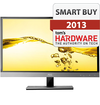 |
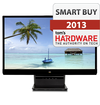 |
 |
 |
| Pricing | ||||
| Screen Size | 27-inch | 27-inch | 27-inch | 27-inch |
| Aspect Ratio | 16:9 | 16:9 | 16:9 | 16:9 |
| Panel Type | AH-IPS | AH-IPS | AH-IPS | AH-IPS |
| Backlight Type | W-LED | W-LED | W-LED | W-LED |
| Max Resolution | 1920x1080 | 1920x1080 | 1920x1080 | 2560x1440 |
| Max Refresh Rate | 60Hz | 60Hz | 60Hz | 60Hz |
| Color Depth | 8-bit (6-bit w/FRC) | 8-bit (6-bit w/FRC) | 8-bit | 8-bit |
| Color Gamut | sRGB | sRGB | sRGB | sRGB |
| Response Time (GTG) | 5ms | 7ms | 7ms | 6.5ms |
| Brightness | 250cd/m² | 250cd/m² | 250cd/m² | 440cd/m² |
| Video Inputs | 2 HDMI, 1 VGA | 1 DVI, 1 HDMI, 1 VGA | 1 DisplayPort, 1 DVI, 1 VGA | 1 DisplayPort, 1 DVI, 1 HDMI, 1 VGA |
These screens are designed to be work-all-day tools suitable for a wide variety of productivity applications. Some may have wide gamuts, but only sRGB is necessary in this category. Measuring 27 inches and up, QHD resolution has become the new standard. FHD is still acceptable at 24 inches and below. We’re also looking for high contrast and, of course, accuracy.
- Out-of-box color and grayscale errors of less than four Delta E
- Color and grayscale can be calibrated to errors of less than three Delta E
- Gamma tracking should be close to 2.2
- Contrast ratio of over 1000 to 1
- Screen uniformity should be less than 10 percent for both white and black fields
AOC I2757Fh
2013 Smart Buy
In early 2013, the big news in monitors was a proliferation of IPS-based models. At that point in time, TN was the dominant technology in low-priced screens, and image quality suffered for it. Hampered by poor viewing angles and washed-out color, professionals begged for a display that would up the ante without hammering them on price.
IPS and its similar counterpart PLS fixed the viewing angle problems, simultaneously bringing color reproduction and accuracy to the next level. Like any new tech, it was expensive at first. But AOC managed a breakthrough with the I2757Fh. For around $300 you get a 27-inch FHD panel made with an AH-IPS part from LG. All you really give up is the extra pixel density of a QHD monitor.
Despite being almost two years old, we think the I2757Fh’s styling still holds up well with a flush bezel front panel and a nicely finished stand. The only things lacking are height and swivel adjustments and a VESA mount. If you want to use an aftermarket bracket, you’ll have to look elsewhere.
Performance-wise, it’s every bit the equal of new models. The I2757Fh looks decent out of the box, but an instrumented calibration will definitely be rewarded. Grayscale, gamma and color accuracy are above-average for the business class. In fact, we used it as a reference display until it was replaced by a Planar PXL2790MW. Read the Full Review
ViewSonic VX2770Smh
2013 Smart Buy
Not to be outdone, ViewSonic brought out its VX2770Smh 27-inch IPS/FHD monitor at about the same time as AOC’s offering. Sporting the same AH-IPS panel with a W-LED backlight, you can find this panel today for around $250. That’s about the best bang-for-the-buck we can imagine in a 27-inch monitor.
ViewSonic goes for a more industrial look with a beefy stand and thicker panel, but retains the same flush bezel as AOC. Like that screen, it’s limited to tilt only; there’s no provision for height, swivel or portrait adjustments. It does include a VESA mount however, making it easy to group two or three (or even four) of them in a nice multi-screen configuration.
The VX2770Smh’s performance is quite good in the contrast department, exceeding our standard of 1000:1 in both default and calibrated states. In the grayscale and color gamut tests, the screens are comparable. Of course, the best reason to buy either display is their superb viewing angle results. With an IPS panel, you don’t need to worry about image quality when you’re sitting off-center. And there's no color shift and only a minimal light falloff at up to 45 degrees.
It’s pretty much a wash between the AOC and ViewSonic products. Att the moment, though, the ViewSonic is a bit cheaper. Read the Full Review
HP EliteDisplay E271i
It seems the vast majority of monitors we review pack 2560x1440 resolutions, but 1920x1080 is still the most common pixel count found on today’s desktops. The HP EliteDisplay E271i is not only the best FHD monitor we’ve reviewed, it out-performs many QHD screens that cost significantly more. Based on a high-quality IPS panel, it delivers the best performance in the business class category. Its calibrated contrast ratio easily tops 1000:1 and it has accurate color right out of the box. If you calibrate, it gets even better. And gamers looking for a solid do-everything monitor will appreciate its low input lag. Couple that with high-end build quality and decent pricing and you have a monitor that's hard to beat for general tasks. Read the Full Review
Planar PXL2790MW
Shortly after we reviewed the HP E271i, Planar's PXL2790MW arrived at the lab. Its image quality is stunning thanks to a front screen layer that's bonded to the TFT, eliminating the clarity-robbing air gap. It also sports tremendous light output, creating a great option for photographers who need a screen they can see outdoors in bright sunlight.
After calibration, its grayscale, gamma and color accuracy rival many pro screens. This is a great choice for business users or graphics pros who only need an sRGB color gamut. Input lag is a little high for gaming, but for all other tasks, superb clarity makes the PXL2790MW one of our favorites. Read the Full Review
MORE: All Monitor Articles
MORE: Latest Monitor News
MORE: Displays in the Forums
Professional
| 2014 Elite | 2014 Elite | 2014 Smart Buy | 2013 Smart Buy | |
| Products |
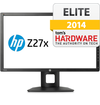 |
 |
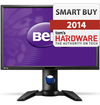 |
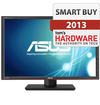 |
| Pricing | ||||
| Screen Size | 27-inch | 27-inch | 24-inch | 27-inch |
| Aspect Ratio | 16:9 | 16:9 | 16:10 | 16:9 |
| Panel Type | AH-IPS | AH-IPS | AH-IPS | AH-IPS |
| Backlight Type | GB-r-LED | GB-r-LED | GB-r-LED | GB-r-LED |
| Max Resolution | 2560x1440 | 2560x1440 | 1920x1080 | 2560x1440 |
| Max Refresh Rate | 60Hz | 60Hz | 60Hz | 60Hz |
| Color Depth | 10-bit | 10-bit | 10-bit (8-bit w/FRC) | 10-bit (8-bit w/FRC) |
| Color Gamut | AdobeRGB+ | AdobeRGB | AdobeRGB | AdobeRGB |
| Response Time (GTG) | 7ms | 6ms | 5ms | 6ms |
| Brightness | 250cd/m² | 340cd/m² | 350cd/m² | 350cd/m² |
| Video Inputs | 2 DisplayPort, 1 HDMI | 2 DisplayPort, 1 DVI, 1 HDMI | 1 DisplayPort, 1 DVI, 1 HDMI, 1 Mini DisplayPort, 1 VGA | 1 DisplayPort, 1 DVI, 1 HDMI |
For a monitor to earn the professional classification, it must deliver perfectly accurate color, grayscale and gamma.
- No measured color or grayscale error should be over three Delta E
- Gamma should track either 2.2 or BT.1886
- Screen uniformity should be less than 10 percent for both white and black fields
- Color uniformity should measure less than three Delta E
- Both sRGB and Adobe RGB gamuts should be supported
HP Z27x
2014 Elite
Designed with input from elite post-production houses, the HP Z27x provides a real alternative to frightfully expensive professional mastering monitors that can cost upwards of $15,000. For about a tenth of that, you can have spot-on color accuracy, superior image quality, and a neat internal calibration engine that can adjust itself in just a few minutes. Add to that remote control capabilities, support for every conceivable color gamut, and the ability to accept signals up to 4096x2160 pixels and you have a veritable Swiss Army knife. Anyone working on today’s CGI-laden Hollywood films would do well to give this HP serious consideration. Read the Full Review
NEC PA272W
2014 Elite
NEC's PA272W won't calibrate itself like the HP. But thanks to a superb OSD and one of the best color management systems we've seen, it can be adjusted to perfection. If you don't have CalMAN, NEC offers an excellent auto-cal application called SpectraView that makes the procedure quick and painless.
The monitor also exposes multiple color gamuts that go all the way up to DCI, so it's suitable for Hollywood film CGI and post-production work. Our review sample measured just average for color and grayscale accuracy, but we're told by NEC that the issue was corrected at the manufacturing level. So, if you buy one today, it shouldn't need calibration unless you require ultimate accuracy.
Compared to special mastering monitors that can cost $15,000 or more, NEC makes a serious statement with its latest PA-series display. Read the Full Review
BenQ PG2401PT
2014 Smart Buy
The bulk of professional monitors we review measure 27 inches or more in size and sport at least QHD (2560x1440) resolution. BenQ offers an alternative in the PG2401PT. It runs at 1920x1200 (yes, that is indeed 16:10), uses a high-quality 24-inch IPS panel with a GB-r-LED backlight and offers the Adobe RGB color gamut. The screen is designed primarily for the print industry with a few gamut options you won’t find elsewhere like Illuminant A and D50, which simulate different lighting conditions.
In our tests, we found the best feature to be superb out-of-box accuracy. Although we performed a full calibration, the results were only altered by a tiny amount. Without adjustment, the PG2401PT’s grayscale error was a mere 1.16 Delta E, returning a phenomenal gamut result of .6 Delta E. Even though most graphics pros calibrate their monitors, this BenQ product works just fine as it comes from the factory.
Even though native resolution is relatively low, its screen size translates to a pixel density of 94PPI, only 14 less than a 27-inch QHD display. A price tag of almost $1000 is expensive, to be sure. But the PG2401PT’s accuracy and performance are hard to beat. Read the Full Review
Asus ProArt PQ279Q
2013 Smart Buy
Our earliest pro monitor reviews always lamented the fact that there was no sRGB option on wide-gamut displays. Asus changed the game with its PA279Q. We called it “the Cadillac of monitors” at the time because it did, and still does, give you everything you need. In addition to selectable color gamuts, you'll enjoy six USB 3.0 ports, a factory-certified calibration, on-screen alignment grids and even a light-blocking hood included in the box. It truly represents a one-stop-shopping package for graphics and photography professionals.
In contrast testing, every result is either just under or just over 1000:1. A year ago, this was one of the most consistent monitors we’d seen and it remains so today. In its pre-calibrated sRGB and Adobe RGB modes, it’s pretty much a fire-and-forget display. Sure, you can calibrate, but you don’t really need to.
In our color gamut tests, Asus achieves ultra-low errors of 1.75dE for sRGB and 1.63dE in Adobe RGB mode. Considering that’s an average of 30 measurements, we’re talking serious accuracy here.
While most business users don’t need a display this precise, it’s still a great choice for day-to-day tasks. It has an IPS panel, LED backlight and superb build quality. If you don’t mind spending $1000 on a 27-inch monitor, the Asus PA279Q won’t disappoint. Read the Full Review
MORE: All Monitor Articles
MORE: Latest Monitor News
MORE: Displays in the Forums
Ultra HD
| 2014 Elite | 2015 Editor Recommended | 2015 Editor Recommended | 2015 Editor Recommended | 2014 Smart Buy | 2014 Smart Buy | 2015 Editor Approved | ||
| Products |
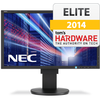 |
 |
 |
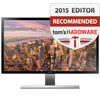 |
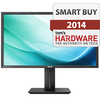 |
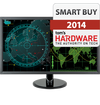 |
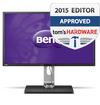 |
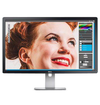 |
| Pricing | ||||||||
| Screen Size | 24-inch | 28-inch | 32-inch | 28-inch | 28-inch | 28-inch | 32-inch | 32-inch |
| Aspect Ratio | 16:9 | 16:9 | 16:9 | 16:9 | 16:9 | 16:9 | 16:9 | 16:9 |
| Panel Type | AH-IPS | TN | IGVO | TN | TN | TN | IPS | IPS/IGZO |
| Backlight Type | GB-r-LED | W-LED, edge array | W-LED | W-LED | W-LED | W-LED | W-LED | W-LED |
| Max Resolution | 3840x2160 | 3840x2160 | 3840-2160 | 3840x2160 | 3840x2160 | 3840x2160 | 3840x2160 | 3840x2160 |
| Max Refresh Rate | 60Hz | 60Hz | 60Hz | 60Hz | 60Hz | 60Hz | 60Hz | 60Hz |
| Color Depth | 10-bit (8-bit w/FRC) | 10-bit (8-bit+FRC) | 10-bit w/14-bit LUT | 10-bit (8-bit w/FRC) | 10-bit (8-bit w/FRC) | 10-bit (8-bit w/FRC) | 10-bit (8-bit w/FRC) | 10-bit |
| Color Gamut | AdobeRGB | sRGB | Adobe RGB | sRGB | sRGB | sRGB | sRGB | AdobeRGB |
| Response Time (GTG) | 6ms | 5ms | 01ms | 1ms | 1ms | 5ms | 4ms | 8ms |
| Brightness | 350cd/m² | 300cd/m² | 350cd/m² | 370cd/m² | 330cd/m² | 300cd/m² | 350cd/m² | 350cd/m² |
| Video Inputs | 2 DisplayPort, 2 DVI, 2 HDMI (1 x MHL) | 2 DisplayPort, 1 DVI, 2 HDMI/MHL | 2 DisplayPort, 4 HDMI, 2 DVI | 1 DisplayPort, 2 HDMI | 1 DisplayPort, 2 HDMI | 2 DisplayPort, 1 DVI, 2 HDMI, 1 VGA | 2 DisplayPort, 2 HDMI, 1 DVI | 1 DisplayPort, 1 HDMI, 1 DVI |
Ultra HD monitors differ from their lower-resolution counterparts in only one area – pixel count. Our standards for color accuracy, contrast, brightness and speed are the same as those for business-class displays.
- Out-of-box color and grayscale errors of less than four Delta E
- Color and grayscale can be calibrated to errors of less than three Delta E
- Gamma tracking should be close to 2.2
- Contrast ratio of over 1000 to 1
- Screen uniformity should be less than 10 percent for both white and black fields
NEC EA244UHD
2014 Elite
Even though the EA244UHD is part of NEC’s business-class line, it has nearly every feature available in the high-end PA models. You get an Adobe RGB gamut option and SpectraView calibration, just like the PA line, along with amazing out-of-box accuracy. In fact, when we ran our tests, we were unable to improve any of the default results with calibration. Without making a single adjustment, this NEC is more accurate than most monitors after calibration.
At 184PPI, 24-inch UHD monitors represent the highest possible pixel density available right now. In Windows, this means fonts and icons are going to be super small if you don't use DPI scaling. Meanwhile, photos and other graphics look simply stunning. You cannot see the pixel structure, no matter how close you sit or how good your vision is. When Microsoft catches up in the scalability department, everything displayed on a monitor like this will be amazing to look at.
If you’re looking for a luxury business-class screen that outperforms many professional displays, look no further. Priced around $1300, this monitor has a fairly high buy-in. But the EA244UHD's build quality and accuracy have few equals. It works equally well for your daily tasks and higher-end graphics applications. Such a well-rounded showing earned our coveted Tom’s Hardware Elite Award. Read the Full Review
Monoprice CrystalPro 4K
2015 Editor Recommended
We’ve always had decent luck getting press samples from mainstream manufacturers. But there are smaller companies out there offering great products at lower prices. To help round out our coverage, we approached Monoprice and were rewarded with several monitors to test. The 30-inch IPS LED 16:10 screen we reviewed recently offered reasonable if dated performance but we were really wowed by the 28-inch CrystalPro 4K.
At first glance it seems like a me-too product with its 28-inch TN panel in Ultra HD (3840x2160) resolution. With everyone jumping on the cheap-4K bandwagon, it seems like a predictable product. But once we tested and used it, we found it to perform better than most of the competition. In fact, thanks to an optically-clear front layer, it offers the best clarity and sharpness in the class.
In our benchmark tests it placed high for calibrated contrast, grayscale tracking, and color gamut performance. It also offers five digital inputs with both HDMI ports supporting MHL. You won’t need a matrix box to handle simultaneous viewing of up to four sources. And it has a menu system that ranks among the best for ease-of-use and flexibility.
Considering Monoprice markets literally thousands of different products; and they’re best known for value-priced cables, the CrystalPro 4K is a pleasant surprise in a fairly crowded category. We gave it our Tom’s Editor Recommended award, and we suggest those looking for an inexpensive Ultra HD screen to give it a serious look. Read the Full Review
NEC PA322UHD
2015 Editor Recommended
If you are looking for a wide-gamut option in your next Ultra HD monitor, choices are somewhat limited. There are several 24-inch screens that fit the bill from Dell, NEC and ViewSonic. But until now, only the Dell UP3214Q offered the Adobe RGB gamut in a 32-inch size. NEC is a little late to the party but as we quickly found out in our tests, the PA322UHD has been well-worth the wait.
Every 32-inch UHD monitor except the BenQ BL3201PT is based on Sharp’s IGZO parts. This IPS-type technology has the potential to offer faster pixel response and lower power consumption than traditional IPS by virtue of a new liquid crystal material, indium gallium oxide. Traditional LCDs use amorphous silicon which has 20-50 times less electron mobility.
The PA322UHD doesn’t realize the possibilities of a super-fast panel but it does offers everything a professional photographer or video technician might need. In addition to the Adobe RGB gamut, there is an sRGB option plus an extensive calibration menu. You can control the color points with a traditional CMS or enter in the x & y coordinates for a super-precise setup. The monitor can also be calibrated with NEC’s SpectraView software, or you can plug an instrument directly into the display’s USB hub and calibrate it without a computer.
Our tests prove once again that NEC is devoted to accuracy and performance. It tops 1000:1 in almost all our contrast tests and posts an amazing 1015.2:1 result for the ANSI test. Grayscale numbers before calibration are only 1.14dE and 1.60dE for the sRGB and Adobe RGB modes respectively. After calibration they drop to a super-low .61dE and .46dE. Color gamut results are equally impressive with average errors of .82 for the sRGB mode and .91 for Adobe RGB. With numbers like that, it’s hard to imagine better performance at any price.
The PA322UHD is most definitely a premium product but if you are looking for the ultimate color-accurate professional tool, this monitor has few equals. Read the Full Review
Samsung U28D590D
2015 Editor Recommended
We’ve reviewed six 28-inch Ultra HD/TN monitors now and they are definitely not created equal. Innolux provides the core panel part for all of them but performance varies a bit as do features. In November Planar’s IX2850 earned our Tom’s Smart Buy Award and in January, Samsung managed to do the same with its U28D590D; also known as the UD590.
Despite its reliance on old-school TN technology, the UD590 delivers excellent color accuracy with only a small color gamut error of 1.72dE average. That’s fairly close to some of the expensive professional screens we’ve tested. Grayscale numbers are even better at .76dE calibrated. You can get an excellent picture without calibration too as the error is only 2.11dE out of the box. And the gamma tracks almost perfectly flat with a mere .08 difference between the largest and smallest values.
Of course we consider contrast to be the metric with the greatest impact on image quality. The UD590 runs mid-pack when compared to like monitors from Dell, Planar, Asus and Philips. But a calibrated ratio of 737.5:1 isn’t too bad in the scheme of things. And it maintains that result in the ANSI test which is a very good thing. It’s also the brightest of all at over 360cd/m2 peak.
The one feature that sets it apart from the others is Samsung’s own Magic Angle option. It’s an effective way of improving off-axis viewing by strategically changing the display’s gamma. It sounds gimmicky on paper but in our usability tests it worked extremely well. You simply set the mode you want (there are five options) and the image looks better from the side, top or when you’re leaning back in your chair. We thought it was pretty cool.
With 24 and 32-inch Ultra HD monitors priced higher, the Samsung UD590 is great value and very worthy of consideration. Read the Full Review
Asus PB287Q
2014 Smart Buy
Back in May, we reviewed the very first sub-$1000 Ultra HD panel: Asus’ PB287Q. It sold for around $650 back then. But today it costs closer to $550.
Based on the same Innolux (formerly Chi Mei) TN panel, it has a white-LED backlight and a brightness of around 300cd/m2 in our tests. Contrast is decent at over 800:1 and remains consistent at all backlight levels. It also sports decent out-of-box grayscale and color; the benchmark results are decent enough that calibration is not required (but do it anyway if you can). Our only real complaint is poor off-axis image quality, which is typical of other modern twisted-nematic panels.
If you can live without IPS, the PB287Q offers excellent picture quality, 60Hz operation over DisplayPort and good gaming cred in the form of fast panel response and relatively low input lag. If you want 144Hz and G-Sync, you’ll have to give up 48 pixels-per-inch and go for something like the ROG Swift, which costs quite a bit more. For those who place pixel density and clarity above speed, though, this Asus makes a compelling and extremely value-oriented choice.
In our original review we gave the PB287Q a Smart Buy Award because it represented a real breakthrough in the price-per-pixel metric. Since then, other manufacturers have come out with monitors based on the same panel. They just haven't matched its performance. In fact, we think the only real competition is Planar's IX2850. They cost about the same, so this particular choice could simply come down to availability. You won’t be sorry with either display. Read the Full Review
Planar IX2850
2014 Smart Buy
We were just finishing up our review of the IX2850 when we published November’s monitor guide. Now we can go on record as saying this is the best 28-inch Ultra HD screen we’ve tested. If your first reaction is, “You haven’t tested the Samsung UD590,” then don't worry; we have it in our lab right now. That review will publish soon.
While we still prefer IPS or PLS panels for their image quality and usability, TN has definitely progressed in the past year. It’s still favored by gamers for speed and price. Planar is extremely picky about the parts it uses, as evidenced by the amazing clarity of the PXL2790MW IPS/QHD monitor.
To set itself apart, Planar adds lots of extra inputs and a built-in four-channel matrix component. This means you can display the content of up to four sources at once without additional software or hardware. The IX2850 is therefore perfect for security applications, too. Its 157PPI density creates super-sharp images no matter how many signals are shown. We were hoping for another bonded-screen application like the PXL2790MW. But even though Planar uses a traditional anti-glare layer, it still looks better than the competition.
For those users wanting to game in 4K, the IX2850 is one of the fastest Ultra HD screens available right now. In fact, it finished second in our input lag test by only one millisecond to Asus' PG287Q. You don't get G-Sync or 144Hz support. Still, in some titles, those extra pixels really add to the immersion factor. If you’re looking for the best Ultra HD monitor under $600, look no further than the Planar IX2850. Read the Full Review
BenQ Bl3201PT
2015 Editor Approved
Back in August of 2014, we reviewed BenQ’s BL3200PT. It was, and still is, one of the best jumbo screens we’ve ever tested. With a high-contrast VA panel and QHD resolution, it offers everything to fulfill your big-screen dreams save one thing – Ultra HD resolution.
BenQ rectified that recently with its BL3201PT. Believe us there’s more added here than just an increment to the model number. Now you get those extra pixels in a 32-inch screen size. But here’s the best part – we’ve seen this display selling for under $1000 on the street. That’s a major price breakthrough considering the three IGZO monitors from Sharp, Dell and Asus are still fetching at least $1400 at the time of this writing. There are only two things missing here, the super-high contrast VA panel and a wide gamut; which you can still only get in the Dell UP3214Q.
We’ve talked many times about having the correct pixel density for Windows. More is not necessarily better. Once you have to resort to font scaling, image quality suffers for sure. At 32 inches, Ultra HD resolution actually works. You won’t have to use scaling and text is perfectly readable by those with average vision; or even below-average like myself.
It also doesn’t hurt that the BL3201PT doesn’t require calibration. Our out-of-box measurements proved that it can be used just fine without adjustment. Simply set brightness to taste and enjoy. It also proved quite responsive in our speed tests. If BenQ could overclock it to 120Hz, and perhaps add frame-rate matching, it would have the object of desire in the gaming world. There’s nothing quite like playing your favorite title on a jumbo screen at Ultra HD resolution. Throwing in 120Hz and FRM would pretty much constitute nirvana. For now though, we urge you to give the BL3201PT a serious look. Read the Full Review
Dell UltraSharp UP3214Q
Dell’s UP3214Q is part of the first-generation product cycle. And now that we’ve seen and tested most of the 4K monitors out there, we find it has more to offer than pretty much every other example.
First off, it’s the only 32-inch UHD display to include an Adobe RGB color gamut. At around $1700, pricing lands right in the middle between Sharp's PN-K321 and Asus' PQ321Q. Since you don’t get the wide-gamut option from either Asus or Sharp, Dell becomes an obvious choice.
With UHD, screen size is king because Windows still doesn’t look great when DPI scaling is employed. It certainly improved with each version from 7 onward, but compared to Mac OS, image quality still lags. Until Microsoft includes better support for high pixel densities, you’ll always want to consider the largest monitor possible if Ultra HD is your goal.
In our testing, the UP3214Q proved to be tops in contrast and color accuracy versus the other two 32-inch IGZO-based displays. Grayscale and gamma results were also worthy of a professional designation. If you don’t intend to calibrate, that’s OK because each monitor comes with a factory-certified data sheet attesting to that sample’s out-of-box accuracy. Calibration can be accomplished via the OSD or the included software. With two programmable modes, you can create custom presets to satisfy any gamut from sRGB to Adobe RGB.
The UP3214Q is still expensive. But considering it was selling for over $3000 when it launched, we have to be happy that UHD prices are falling, allowing more enthusiasts to flirt with ultra-high resolutions. Read the Full Review
MORE: All Monitor Articles
MORE: Latest Monitor News
MORE: Displays in the Forums
Ultra-Wide
| 2013 Smart Buy | 2015 Editor Approved | ||
| Products |
 |
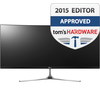 |
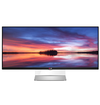 |
| Pricing | |||
| Screen Size | 29-inch | 34-inch | 34-inch |
| Aspect Ratio | 21:9 | 21:9 (curved) | 21:9 |
| Panel Type | AH-IPS | AH-IPS | AH-IPS |
| Backlight Type | W-LED | W-LED | W-LED |
| Max Resolution | 2560x1080 | 3440x1440 | 3440x1440 |
| Max Refresh Rate | 60Hz | 60Hz | 60Hz |
| Color Depth | 8-bit | 8-bit | 10-bit (8-bit w/FRC) |
| Color Gamut | sRGB | sRGB | sRGB |
| Response Time (GTG) | 5ms | 5ms | 14ms |
| Brightness | 300cd/m² | 300cd/m² | 320cd/m² |
| Video Inputs | 2 DisplayPort (In/Out), 1 DVI, 1 HDMI, 1 VGA | 1 DisplayPort, 2 HDMI, 2 Thunderbolt | 1 DisplayPort, 2 HDMI, 2 Thunderbolt |
In our first Ultra-Wide monitor review, we said that the 21:9 aspect ratio was an answer to a question no one was asking. Since then, larger, higher-res and even curved screens have started to appear. Thus, we felt it relevant to select the better examples for coverage on Tom's Hardware.
Our testing standards are the same as for business-class monitors.
- Out-of-box color and grayscale errors of less than four Delta E
- Color and grayscale can be calibrated to errors of less than three Delta E
- Gamma tracking should be close to 2.2
- Contrast ratio of over 1000 to 1
- Screen uniformity should be less than 10 percent for both white and black fields
AOC Q2963PM
2013 Smart Buy
A 21:9 display is not for everyone. Still, some users find them handy alternatives to a multi-panel setup. We reviewed two first-gen ultra-wide monitors last year: NEC’s EA295WMi and the AOC Q2963PM. Both screens posted excellent benchmark results, but AOC's offering comes in at around $200 cheaper.
The company includes some very handy software with its Q2963PM in the form of a window manager. This app makes it super easy to automatically size and arrange windows in up to four preset areas of the screen.
In our benchmark tests, we noted this display's high contrast ratio in both calibrated and ANSI forms. Color and grayscale accuracy aren’t quite in the realm of a professional-class monitor. But at 1.48 and 1.19 Delta E, respectively, they’re not far from perfect.
Our only beef is that, for a 21:9 screen, AOC's Q2963PM is a little small. That's why we're suggesting an alternative in LG's 34UM95 as well. If you're on a budget though, the Q2963PM is one of the least-expensive ultra-wide monitors available. Given excellent performance and great value, it deserves to be on your short list. Read the Full Review
LG 34UC97
2015 Editor Approved
Curved monitors appeared in nearly every manufacturer’s booth at this year’s CES. HP, Samsung, Dell and AOC all showed off 34-inch ultra-wides as well as 27-inch 16:9 screens. But at this time, LG is the only manufacturer actually producing curved panel parts so it’s only fitting that its curved monitor was first-to-market a couple of months ago. Luckily for us, a sample showed up in our labs for testing and review – the 34UC97.
Reader feedback seems split evenly between “like the curve” and “why the curve?” We weren’t sure ourselves until we tried it out. It’s more subtle than it appears in photos. There is plenty of debate about the science behind it; whether it matches the curve of the eye, does it actually encompass human peripheral vision, for example. But in use, it works quite well. We already liked the ultra-wide form factor as a way to keep more apps open and provide a smaller-footprint alternative to multiple screens. Adding the curve simply means we turn our heads less from one side to the other.
The 34UC97 is costly for sure but besides the curve, it has a lot to offer. Calibrated contrast is nearly 1000:1 which is our benchmark; mainly thanks to deep black levels. Grayscale tracking is a decent 2.57dE uncalibrated and an excellent .72dE when adjusted. There’s also a color management system which helped us achieve an average gamut error of 2.15dE. For graphics pros seeking a little extra color in an sRGB monitor, you’ll get it here because we measured a volume of 101.94 percent.
The curve may not appeal to everyone but we urge you to check the 34UC97 out in person before rendering judgment. We enjoyed using it and were sorry to see it go back to LG. We’ll be checking out more of these curved beauties in the coming months. Read the Full Review
LG 34UM95
We consider ultra-wide monitors to be niche products. Their short 11.4-inch height in the 29-inch size makes them a bit squished for productivity tasks like Web browsing and word processing. LG recently answered that concern perfectly with its 34UM95. Measuring 34 inches diagonally, it assumes the exact height of our current favorite monitor class, the 27-inch QHD display. That means you get the same 109PPI density and a bonus 7.75 inches of screen width.
LG also supplies a window manager with the 34UM95, so it’s a snap to arrange windows in a multiple desktop-style configuration. Another feature unique to this model is a Thunderbolt port. It’s the first monitor we’ve seen outside of an Apple store that actually caters to Mac users.
We were able to calibrate the 34UM95 to a fairly high standard of .93 Delta E for grayscale and 1.18 Delta E for color gamut. Along with tight gamma tracking and decent contrast, the LG’s image quality is excellent. Our only complaint is the price. At around $1000, it’s pretty much consigned to the luxury business class category.
If you have the budget and desire for a beautifully-styled unique-looking monitor, you won’t find much that eclipses LG's 34UM95, except perhaps the curved-screen version expected next month. Stay tuned! Read the Full Review
MORE: All Monitor Articles
MORE: Latest Monitor News
MORE: Displays in the Forums
Jumbo
There’s nothing quite like having a giant monitor on your desktop. Many users prefer this to multiple displays. Once the resolution passes QHD, the available screen real estate means you can have many windows open simultaneously, streamlining personal productivity. Panels this big are rare and expensive, but with 27 inches becoming the new standard, we foresee more 30-inch and larger monitors in the future.
- All parameters from the Business-class category plus:
- Screen size of at least 30 inches diagonal
BenQ BL3200PT
We reviewed a couple of 30-inch monitors last year and wished for more jumbo displays to come our way. BenQ answered our call with the BL3200PT. It’s an AMVA design. And with 2560x1440 pixels, it has a density of 92PPI. That hits a sweet spot with Windows because you don’t have to use DPI scaling to make text readable. And you get the extra screen real estate QHD is famous for. The AMVA panel means contrast is roughly double that of an IPS or TN display, and the black level is extremely low. We loved watching movies on it as much as working on more mundane tasks.
Although it’ll set you back almost $1000, 437 square inches of screen area are hard to ignore! Read the Full Review
Technical Specifications
- Screen Size :
- 32-inch
- Aspect Ratio :
- 16:9
- Panel Type :
- AMVA
- Backlight Type :
- W-LED
- Max Resolution :
- 2560x1440
- Max Refresh Rate :
- 60Hz
- Color Depth :
- 10-bit
- Color Gamut :
- sRGB
- Response Time (GTG) :
- 4ms
- Brightness :
- 300cd/m²
- Video Inputs :
- 1 DisplayPort, 1 DVI, 1 HDMI, 1 VGA
Stay tuned as we bring continuing coverage of all the latest display technologies with our hands-on reviews and up-to-date news of products in development.
MORE: Latest Monitor News
MORE: Displays in the Forums
Christian Eberle is a Contributing Editor for Tom's Hardware, covering Monitors and TVs.




























